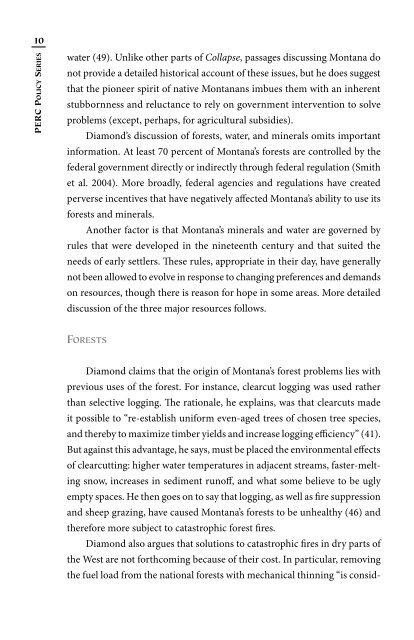Montana: On the Verge of Collapse - PERC
Montana: On the Verge of Collapse - PERC
Montana: On the Verge of Collapse - PERC
Create successful ePaper yourself
Turn your PDF publications into a flip-book with our unique Google optimized e-Paper software.
10<br />
<strong>PERC</strong> POLICY SERIES<br />
water (49). Unlike o<strong>the</strong>r parts <strong>of</strong> <strong>Collapse</strong>, passages discussing <strong>Montana</strong> do<br />
not provide a detailed historical account <strong>of</strong> <strong>the</strong>se issues, but he does suggest<br />
that <strong>the</strong> pioneer spirit <strong>of</strong> native <strong>Montana</strong>ns imbues <strong>the</strong>m with an inherent<br />
stubbornness and reluctance to rely on government intervention to solve<br />
problems (except, perhaps, for agricultural subsidies).<br />
Diamond’s discussion <strong>of</strong> forests, water, and minerals omits important<br />
information. At least 70 percent <strong>of</strong> <strong>Montana</strong>’s forests are controlled by <strong>the</strong><br />
federal government directly or indirectly through federal regulation (Smith<br />
et al. 2004). More broadly, federal agencies and regulations have created<br />
perverse incentives that have negatively affected <strong>Montana</strong>’s ability to use its<br />
forests and minerals.<br />
Ano<strong>the</strong>r factor is that <strong>Montana</strong>’s minerals and water are governed by<br />
rules that were developed in <strong>the</strong> nineteenth century and that suited <strong>the</strong><br />
needs <strong>of</strong> early settlers. These rules, appropriate in <strong>the</strong>ir day, have generally<br />
not been allowed to evolve in response to changing preferences and demands<br />
on resources, though <strong>the</strong>re is reason for hope in some areas. More detailed<br />
discussion <strong>of</strong> <strong>the</strong> three major resources follows.<br />
FORESTS<br />
Diamond claims that <strong>the</strong> origin <strong>of</strong> <strong>Montana</strong>’s forest problems lies with<br />
previous uses <strong>of</strong> <strong>the</strong> forest. For instance, clearcut logging was used ra<strong>the</strong>r<br />
than selective logging. The rationale, he explains, was that clearcuts made<br />
it possible to “re-establish uniform even-aged trees <strong>of</strong> chosen tree species,<br />
and <strong>the</strong>reby to maximize timber yields and increase logging efficiency” (41).<br />
But against this advantage, he says, must be placed <strong>the</strong> environmental effects<br />
<strong>of</strong> clearcutting: higher water temperatures in adjacent streams, faster-melt-<br />
ing snow, increases in sediment run<strong>of</strong>f, and what some believe to be ugly<br />
empty spaces. He <strong>the</strong>n goes on to say that logging, as well as fire suppression<br />
and sheep grazing, have caused <strong>Montana</strong>’s forests to be unhealthy (46) and<br />
<strong>the</strong>refore more subject to catastrophic forest fires.<br />
Diamond also argues that solutions to catastrophic fires in dry parts <strong>of</strong><br />
<strong>the</strong> West are not forthcoming because <strong>of</strong> <strong>the</strong>ir cost. In particular, removing<br />
<strong>the</strong> fuel load from <strong>the</strong> national forests with mechanical thinning “is consid-




